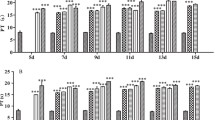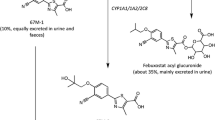Summary
Flomoxef is a new oxacephem of broad antibacterial activity. The compound is mainly excreted through the kidneys. Two dose finding studies in patients with various degrees of renal insufficiency revealed that the dosage of flomoxef has to be reduced exactly according to the renal function. Although the N-methylthiotetrazole group has been replaced by a hydroxyethyl group, an inhibitory effect of flomoxef on vitamin K metabolism persisted. This effect was, however, less pronounced than with latamoxef. Only patients with low vitamin K stores are endangered. For those in whom low vitamin K stores are suspected repeated controls of prothrombin time are advised during the treatment. In contrast to latamoxef the platelet system was not affected by flomoxef. With the exception of loose stools in some patients no other clinical side effects during treatment were observed.
Zusammenfassung
Flomoxef ist ein neues parenterales Oxacephem mit breiter antibakterieller Aktivität. Wegen seiner vorwiegend renalen Elimination muß die Dosierung von Flomoxef der Nierenfunktion angepaßt werden. Hierzu wurden zwei Dosisfindungsstudien durchgeführt. Obwohl in Position 3 des Oxacephemgerüsts N-methyl durch ein Hydroxyaethyl im Thiotetrazolring ersetzt wurde, ist die hemmende Wirkung auf den Vitamin K Metabolismus immer noch nachzuweisen. Dieser kumarinähnliche Effekt ist allerdings deutlich geringer als unter Latamoxef. Deshalb sind nur solche Patienten gefährdet, unter der Therapie mit Flomoxef einen Abfall des Quicktests zu entwickeln, die einen ausgeprägten Vitamin K Mangel aufweisen, wie zum Beispiel Patienten unter totaler parenteraler Ernährung. Bei diesen Patienten sollte der Quickwert unter der Therapie häufiger kontrolliert werden. Im Gegensatz zu Latamoxef hat Flomoxef keinen Einfluß auf die Thrombozytenfunktion. Außer Stuhlgangunregelmäßigkeiten bei einem Teil der Patienten konnten keine zusätzlichen Nebenwirkungen unter der Therapie mit Flomoxef beobachtet werden.
Similar content being viewed by others
References
Tsuji, T., Satoh, M., Narisada, M., Hanashima, Y., Yoshida, T. Synthesis and antibacterial activity of 6315-S, a new member of the oxacephem antibiotic. J. Antibiot. 38 (1985) 466–476.
Neu, H. C., Chin, N. X. In vitro activity and betalactamase stability of a new difluoro oxacephem, 6315-S. Antimicrob. Agents Chemother. 30 (1986) 638–644.
Shearer, M. J., Bechtold, H., Andrassy, K., Koderisch, J., McCarthy, P. T., Trenk, D., Jähnchen, E., Ritz, E. Mechanism of cephalosporin-induced hypoprothrombinemia: Relation to cephalosporin side chain, vitamin K metabolism and vitamin K status. J. Clin. Pharmacol. 28 (1988) 88–95.
Shimizu, K. Flomoxef. Jpn. J. Antibiot. 41 (1988) 1809–1821.
Uchida, K., Takase, H., Nomura, Y., Kakushi, H., Shike, T., Okabayashi, T., Mihara, S. Effect of 6315-S (Flomoxef) on blood coagulation and platelet aggregation. Chemotherapy (Tokyo) 35 (Suppl. 1) (1987) 470–493.
Andrassy, K., Koderisch, J., Fritz, S., Bechtold, H., Sonntag, H. Alteration of hemostasis associated with cefoperazone treatment. Infection 14 (1986) 27–31.
Hirauchi, K., Sakano, T., Morimoto, A. Measurement of vitamins in human and animal plasma by high-performance liquid chromatography with fluorometric detection. Chem. Pharm. Bull. 34 (1986) 845–849.
Hirauchi, K., Sakano, T., Nagaoka, T., Morimoto, A. Simultaneous determination of vitamin K1, vitamin K1 2,3-epoxide and menaquinone-4 in human plasma by high-performance liquid chromatography with fluorometric detection. J. Chromat. 430 (1988) 21–29.
Knothe, H., Dette, G. A., Shah, P. M. Impact of injectable cephalosporins on the gastrointestinal microflora: Observations in healthy volunteers and hospitalized patients. Infection 13 (Suppl. 1) (1985) 129–133.
Fishman, L. S., Hewitt, W. L. The natural penicillins. Med. Clin. North Am. 54 (1970) 1081–1099.
Andrassy, K., Koderisch, J., Fritz, S., Ritz, E. New betalactam antibiotics and hemorrhagic diathesis: Comparison of moxolactam and cefotaxime. Clin. Ther. 6 (1983) 34–42.
Uchida, K., Komeno, T. Relationships between dietary and intestinal vitamin K, clotting factor levels, plasma vitamin K and urinary Gla. In:Suttie, L. W. (ed.): Current advances in vitamin K research. Elsevier Science Publishing Co., Amsterdam 1988, pp. 477–492.
Bechtold, H., Andrassy, K., Jähnchen, E., Koderisch, J., Koderisch, H., Weilemann, L., Sonntag, H., Ritz, E. Evidence for impaired hepatic vitamin K1 metabolism in patients treated with N-methyl-tetrazole cephalosporins. Thromb. Haemost. 51 (1984) 358–361.
Author information
Authors and Affiliations
Rights and permissions
About this article
Cite this article
Andrassy, K., Koderisch, J., Gorges, K. et al. Pharmacokinetics and hemostasis following administration of a new, injectable oxacephem (6315-S, flomoxef) in volunteers and in patients with renal insufficiency. Infection 19 (Suppl 5), S296–S302 (1991). https://doi.org/10.1007/BF01645542
Issue Date:
DOI: https://doi.org/10.1007/BF01645542




